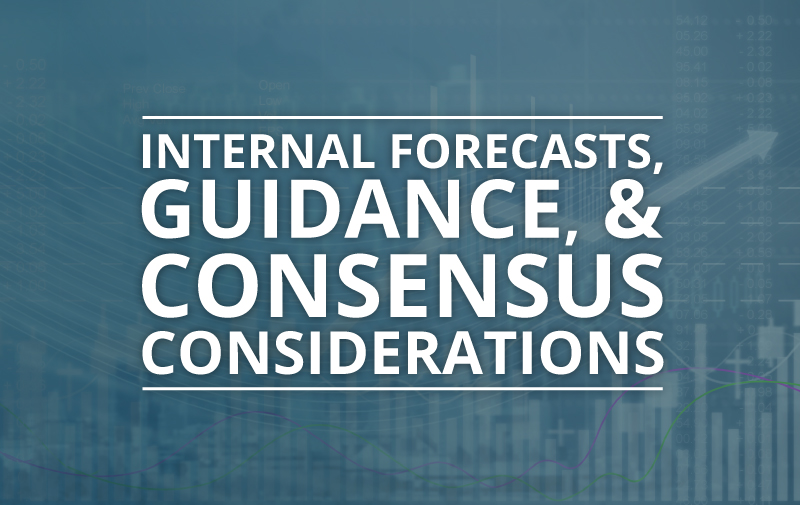At the start of each earnings cycle, one of the first places we look to begin preparations for quarterly reporting is the external consensus numbers (what Wall Street expectations are) and our client’s internal forecasts –for the current quarter, the upcoming quarter and the full year. Topline growth, gross margins, operating expenses, and net income are generally the easiest metrics to pull out and compare when determining where to take the public commentary. Are the current quarter’s actual results in line with expectations? If not, we will need to explain what happened. Are the upcoming quarter’s results in line with the forecast? If not, and we need to adjust, we will need to offer commentary as to why. Looking at the year, are we still on track? If not, what do we see on the horizon that changed?
Hopefully, actual results and external expectations are relatively close, but here are some additional factors to consider as you work through messaging, reporting your quarterly results, and preparing to give guidance.
Internal Forecasts – as the name suggests, keep it internal
Obviously, internal rollups and the resulting forecasts are a starting point for determining guidance. And regardless of where your forecast lands, your external guidance should consider these. However, our (strong) recommendation is to keep it internal. Perhaps this sounds simplistic, but it can be very tempting to share forecasts with your analysts and key investors in candid conversations. Forecasts, though, are not guidance. As you determine what language to use when answering Q&A, consider that saying, “we are forecasting revenue of $45 million” is an entirely different message than, “our guidance is $45 million.”
Public Guidance – be realistic, not optimistic
About a year ago, we published a blog called “What’s the Consensus on Guidance” and highlighted that ninety-four percent of public companies in a NIRI survey responded that they provide some form of guidance (financial, non-financial, or both). This figure is consistent with data dating back to 2009. Of course, the challenge with giving public guidance is providing enough detail to enable an investor to make some reasonable assumptions about your future business without hyping the near-term valuation and disappointing investors down the road. Even for the most conservative management teams, this becomes a challenge when you believe in your business (and your sales team) and don’t want to publicly state expectations for revenue that are lower than what you believe your potential results can be. Moreover, it’s challenging to provide guidance twelve months out when there could be any number of variables from headwinds to tailwinds to macro-economics to the completely unexpected.
So, here is where your internal forecast is so valuable. Your internal forecast is your INTERNAL goal and an obvious starting place. However, we caution our clients to take into consideration the myriad of factors that could impact that forecast and to find a reasonable range for their external guidance. As a suggestion, take the low end of your forecast as the high end of your public guidance and then work backward in determining a range from there. Give your company enough room to move within that range and narrow the gap as the year moves forward. Be realistic, not optimistic, in determining your range.
Following along the P&L, if you’ve decided to provide additional guidance beyond revenue, consider what metrics are important to your investors and which of those reflect the progress of your business. For example, if you are in the capital equipment space, consider providing a range of placements. If you are in growth mode, you may want to offer guidance on GM and OPEX. If profitability is important to your investors, consider guidance on net income. Whatever you decide is right for your company, be prepared to stick with it for at least a year or longer. Finally, look at your forecast to see what those metrics say and whether your public messaging supports those forecasts. For example, we had a client that wanted to give annual guidance on US/OUS sales, but the internal quarterly forecast showed wide volatility on a quarterly basis. So, while the annual guidance may have been an interesting metric, given their goals for the year, updating on quarterly actuals and providing commentary to back it up made that metric more confusing than helpful.
One final note on guidance – we generally recommend annual guidance and then quarterly adjustments on your conference calls, if necessary. This policy will enable you to provide a wider range at the start of the year (typically when a company reports year-end they will provide guidance for the following year) and then narrow or adjust that range throughout the year as you gain more visibility. A recent survey highlighted that 89% of public companies would update financial guidance in the event of a positive or negative material change.
Consensus – what the Street heard
Following the earnings call and commentary on guidance, whether updated or reiterated, your covering analysts will update their models, and this gets reported into the databases of several service providers, which can then be accessed by professional investors. Ideally, the consensus numbers land within the range of the guidance you publicly provided. In general, we see the Street typically go towards the midpoint of your publicly stated guidance range, unless you have offered qualitative commentary that would give an investor the impression you are being overly conservative or bullish. So, as you determine your guidance range, consider where you want consensus to land and the associated commentary you offer in your conference call to justify that range. There will undoubtedly be outliers for a variety of reasons, and many companies don’t have the benefit of a lot of covering analysts to put those outliers in perspective. Regardless, the Street’s consensus numbers are what will set the expectations for the coming quarter and full year, so we place a high priority on factoring that into our investor communication considerations.
Leigh Salvo, Managing Director


Leave a Reply